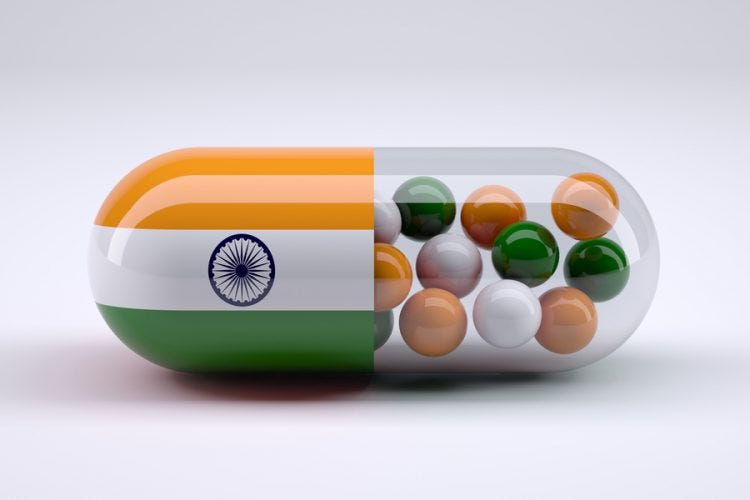
From Branded Gx to Gx Gx — Will Indian Pharma successfully traverse this path? LoEstro Advisors
From Branded Gx to Gx Gx — Will India successfully traverse this path?
Branded, Unbranded and Pure Generics
Unlike an unbranded generic market like the USA, India as a market operates as a Branded Generic which means even generic medications have multiple brands.
In India, even for generic medications — there are multiple brands — and each of them sell at different prices. Sales reps for different companies market them to doctors competing for market share.
In the truest Sense, Trade Gx is really a misnomer as they don’t come in a bottle without the consumer knowing which brand it is — in India, T Gx is the segment where the drugs are not promoted through doctors but directly sold to distributors.
Gx Gx are unbranded generic medicines — these medicines are essentially not marketed by the marketers and there is no brand associated with these medicines. They are sold by their INNs (International Nonproprietary Name). For Example, Disprin is a brand medicine — the INN is acetylsalicylic acid.
Prescription Pull in Branded Gx vs Unbranded Gx Markets
India’s Evolution as a Branded Gx Market
A well-regulated market has built-in regulatory safeguards and strong enforcement mechanisms that ensure high levels of quality compliance and drug safety. Unfortunately, in India, the ground reality has been a far cry from optimum and this has resulted in the market evolving differently.
Lack of Quality Assurance:
In India, there is a lack of standardization of quality control and quality assurance processes in pharmaceutical manufacturing. Only the scaled, well-established players catering to developed markets have good systems in place, the long tail comprising of small unorganized players operate without robust processes putting product quality at risk. This leads to production and distribution of counterfeit, sub-standard and spurious drugs that have adverse patient impact ranging from fatalities and serious health risks to poor drug efficacy among others. This is a serious problem that continues to affect the Indian market.
Brands signal quality and credibility among both doctors and patients — this has directly resulted in the development of strong brands as they are a proxy for product quality.
Lack of Regulatory Enforcement
To say that the enforcement by regulatory authorities on quality is lax would be an understatement. It’s estimated that about 60% of the positions of drug inspectors at Central Drug Standards Control Organization (CDSCO), India’s drug regulator are lying vacant (as of Dec 2023). The story is similar at the state level — key states like AP, Telangana, Gujarat, Maharashtra, WB have over 50% of posts vacant.
With such a paucity of staff — it’s practically impossible to ensure effective monitoring and enforcement of quality and regulatory compliance.
Less than 20% of all domestic plants are WHO-GMP compliant, painting a rather grim picture.Manufacturing Facilities — Approved vs Unapproved
Market Size & Split
Indian Pharma Market is valued at ~$50Bn (FY’23) with a roughly equal split between domestic market and exports. [Source:IBEF]
The total market is projected to reach $130Bn by 2030.
The share of value of the total Market for Branded Gx is currently estimated to be ~85–90% by value and trade generics making up the remaining 10–15% with negligible contribution patented and Gx Gx. This is likely to increase significantly as there is growth in both the Trade Gx and Gx Gx channels.
India Market — BGx, TGx — Key Features
Doctors are key to generating demand for branded Gx players through prescriptions and for each generic drug, there are multiple brands competing for share of the market making it a highly competitive market.
The market is highly concentrated in urban areas with doctors choosing to practice largely in urban areas due to better earnings prospects.
>80% of all doctors in India live in urban India and cater to 1/3rd of the Indian Population which drives high concentration of Pharma sales reps in Urban areas with a disproportionate focus by pharma companies in Urban areas due to a larger market.
Brands also signal quality to doctors and factors like packaging, price, availability, etc. are factors that influence pharma marketing to drive prescriptions by doctors. On average there is a wide range of pricing for medication given the large number of brands — and the more established brands have a good chunk of the market share based on their therapies of focus and geographical areas of coverage.
This market structure allows companies to operate at 25%+ EBITDA margins.
Trade Gx — this is a channel that has been used by Indian pharma cos to improve presence in Tier-3 and Tier-4 towns where the number of doctors is fewer. As there is no field force to promote Trade Gx, companies incentivize retailers by offering higher margins — this is possible as there are no marketing costs incurred. The medicines are priced at a good discount (typically 15–25%) compared to their Branded Gx counterparts making them more lucrative to end customers.
The Trade Gx channel largely has acute therapies and OTC medications.
In the current market, informal substitution at the retailer level exists — the two key drivers behind this is the higher margin offered on Trade Gx (~60%+ channel margin in TGx vs 30% Channel margin in BGx) to the retailer and stock-outs of the prescribed brand.
The Gx Gx channel can see significant growth in Chronic Therapy areas which continue to be largely dominated by Branded Gx medicines and Indian Pharma Cos’ strong hold over doctors, KOLs and prescriptions
The demand generation in the Gx Gx channel would require a shift to a substitutability driven model that would help drive marketing free demand of generics driven through doctor prescriptions.
Currently, the substitution that happens remains largely at the retail pharmacy where it’s predominantly Branded Gx to Trade Gx. Of late, online pharmacy chains have started to offer consumers a choice to substitute medications with lower priced alternatives offering heavy discounts (ranging from 20–50%) — majority of this substitution happening in supplements and non-critical medication.
While B2C remains largely impenetrable for Gx Gx until substitutability becomes a reality, B2B remains a possible segment where Gx Gx can potentially capture a large share of market. Large buyers such as state governments, Armed forces, air force, larger hospital groups procure through an RFP process and the key is to be an empaneled supplier with a good price point. Even today, for some large private groups, the Gx Gx procurement ranges between 10–20% of all procurement. The caveat here is that medicines which are more sensitive to product quality — for instance the ones used in emergency care, injectable medicines, etc. are typically ones where Branded Gx is largely preferred owing to the fact that there are not enough reliable Gx Gx suppliers that can consistently meet quality standards — and this has adverse effects on clinical outcomes especially in acute care settings and hence doctors tend to be risk averse and pay higher for Branded Gx medications.
GOI’s Unbranded Generic Push — Jan Aushadhi Kendras
With the objective of improving access to unbranded generic medicines, GOI launched the PM Bharatiya Janaushadhi Pariyojana (PMBJP) in 2008. Dedicated pharmacy outlets were opened across the country to provide low-cost high-quality medicines. The trajectory is currently on track to reach the target of 10,500 by March 2025.
The sourcing for these medications is done on a tender basis from WHO-GMP approved manufacturers and is attempting to provide quality medicines at affordable prices and has so far passed on ₹18,000 Cr of savings to citizens as the medicines are priced much lower — upto a 90% discount in some cases compared to their branded generic counterparts.
There’s a plan to expand the basket of drugs from a current 1700 drugs to 2500+ to enhance coverage and offer a wider variety of medicines.
GOI is serious about a push towards Substitutability
In August 2023, the National Medical Commission (NMC) released a guideline mandating doctors to only prescribe the generic drug name and also included stiff penalty on doctors for non-compliance. This guideline was however withdrawn very soon given the huge uproar it created — the Indian Medical Association (IMA) and the Indian Pharmaceutical Alliance (IPA) had expressed concern and opposed the regulation citing Drug Quality challenges being the primary reason behind why this move would not be suitable.
In the same month, Ministry of Health and Family welfare has made it mandatory for all MSME drug makers and pharma companies with an annual turnover of 250 Cr and above to adopt Good Manufacturing practices (GMP) within 6 months of starting and for companies with a turnover less than 250 Cr, the time allowed is 12 months.
However, there are rising voices in support of the push towards substitutability. In June 2024, All India Drug Action Network (AIDAN) has written to the Health Ministry opposing the IPA’s stance against substitutability and calling for the constitution of an expert panel to evaluate the feasibility of generic substitution.
The Indian market will move towards Generic Substitutability
Given the intent of the government and the massive success of the JAKs, it’s only a matter of time before the market eventually moves towards generic substitutability. This would require significant investment in improving quality systems, ensuring Bioequivalence of generics, creating strong regulatory frameworks and even stronger enforcement mechanisms. The revised implementation of Schedule M is a welcome step in the right direction. Whether this would take 5 years, or a decade or longer would depend on how much resources GOI puts behind this.
Sooner or later, the market is likely to move away from a branded Gx model thus significantly impacting existing players in the ecosystem.
What does this mean for various stakeholders in the Value chain?
– Manufacturers — Small and Mid-sized manufacturers need to invest in Quality and regulatory compliance to continue to be able to operate in the market and be compliant with changing regulations
– Pharmacy Retailers and Wholesalers — this segment will become more organized with standard practices and effective SOPs to ensure safe dispensing practices
– Doctors — they will move prescriptions to one of the following formats
INN [Company Name]INN [Brand Name]Only INN
– Patients — Patients stand to gain from the consumer surplus that is bound to get generated from the move towards substitutability through paying lower prices for higher quality drugs
– Regulators — increased regulatory spending, more robust guidelines and operational enforcement of compliance guidelines will become the norm with expected initial pains in the form of shutdown of multiple non-compliant units which will expectedly see pushback from industry in addition to the pushback from top bodies like the IPA
The writing on the Wall is clear and it’s imperative for pharma manufacturers in India to adapt and gear up for the change that is inevitable.
To have a more detailed conversation, please write to us at aditya@loestro.com
LoEstro Advisors is an investment banking firm specializing in sell-side fundraise and M&A advisory, along with a strong consulting arm.
Over the last four years, we have grown to be one of India’s largest (in terms of M&A transactions) homegrown boutique investment banks, with $1billion + worth of combined deals closed across education, healthcare, consumer, and technology sectors.

